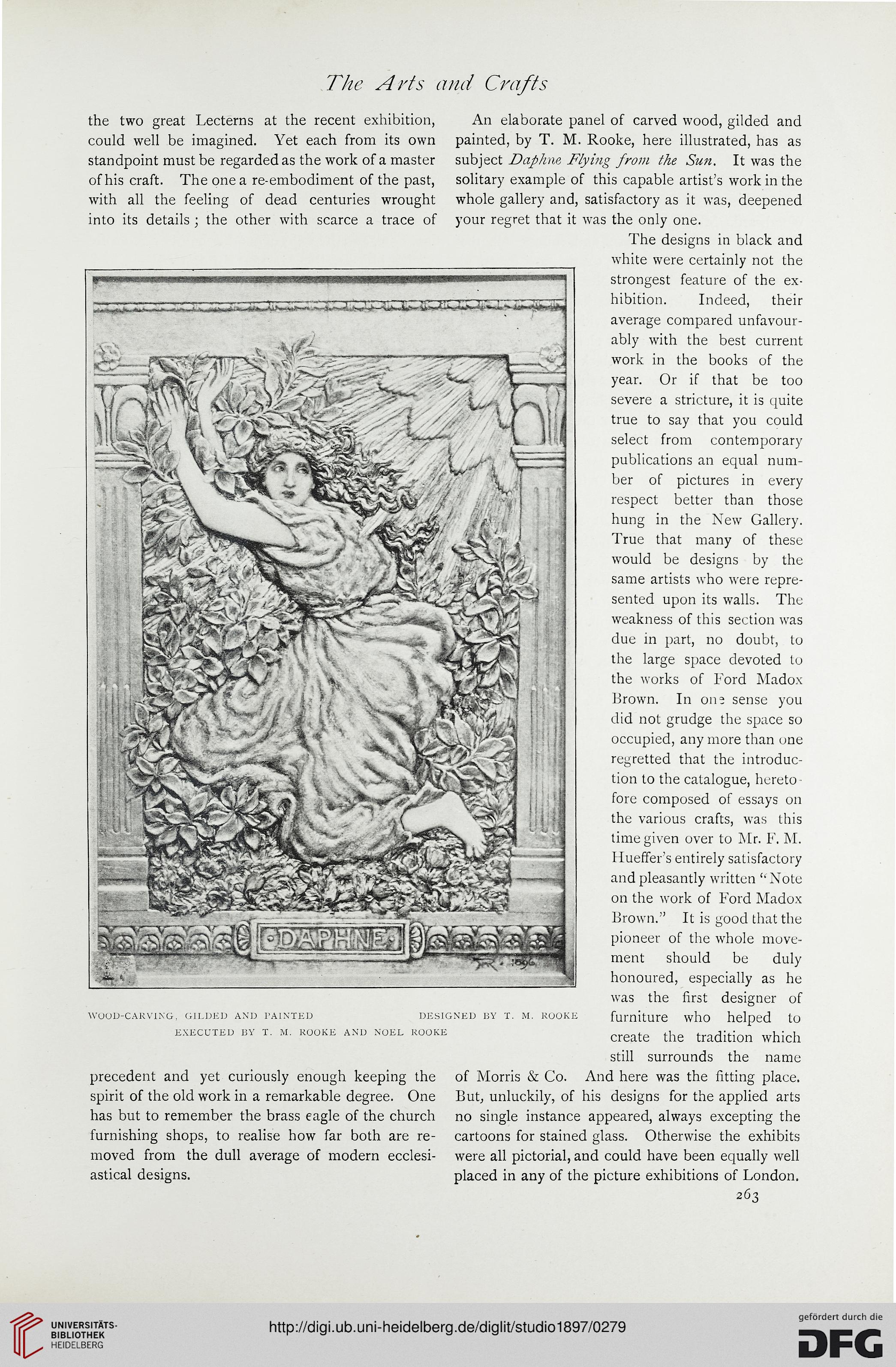The Arts and Crafts
the two great Lecterns at the recent exhibition, An elaborate panel of carved wood, gilded and
could well be imagined. Yet each from its own painted, by T. M. Rooke, here illustrated, has as
standpoint must be regarded as the work of a master subject Daphne, Flying from the Sun. It was the
of his craft. The one a re-embodiment of the past, solitary example of this capable artist's work in the
with all the feeling of dead centuries wrought whole gallery and, satisfactory as it was, deepened
into its details ; the other with scarce a trace of your regret that it was the only one.
The designs in black and
white were certainly not the
strongest feature of the ex-
hibition. Indeed, their
average compared unfavour-
ably with the best current
work in the books of the
year. Or if that be too
severe a stricture, it is quite
true to say that you could
select from contemporary
publications an equal num-
ber of pictures in every
respect better than those
hung in the New Gallery.
True that many of these
would be designs by the
same artists who were repre-
sented upon its walls. The
weakness of this section was
due in part, no doubt, to
the large space devoted to
the works of Ford Madox
Brown. In one sense you
did not grudge the space so
occupied, any more than one
regretted that the introduc-
tion to the catalogue, hereto
fore composed of essays on
the various crafts, was this
time given over to Mr. F. M.
Hueffer's entirely satisfactory
and pleasantly written " Note
on the work of Ford Madox
Brown." It is good that the
pioneer of the whole move-
ment should be duly
honoured, especially as he
was the first designer of
designed by t. m. rooke furniture who helped to
executed by t m. rooke and noel rooke create ^ ^dilion which
still surrounds the name
precedent and yet curiously enough keeping the of Morris & Co. And here was the fitting place,
spirit of the old work in a remarkable degree. One But, unluckily, of his designs for the applied arts
has but to remember the brass eagle of the church no single instance appeared, always excepting the
furnishing shops, to realise how far both are re- cartoons for stained glass. Otherwise the exhibits
moved from the dull average of modern ecclesi- were all pictorial, and could have been equally well
astical designs. placed in any of the picture exhibitions of London.
263
wood-carving, gilded and tainted
the two great Lecterns at the recent exhibition, An elaborate panel of carved wood, gilded and
could well be imagined. Yet each from its own painted, by T. M. Rooke, here illustrated, has as
standpoint must be regarded as the work of a master subject Daphne, Flying from the Sun. It was the
of his craft. The one a re-embodiment of the past, solitary example of this capable artist's work in the
with all the feeling of dead centuries wrought whole gallery and, satisfactory as it was, deepened
into its details ; the other with scarce a trace of your regret that it was the only one.
The designs in black and
white were certainly not the
strongest feature of the ex-
hibition. Indeed, their
average compared unfavour-
ably with the best current
work in the books of the
year. Or if that be too
severe a stricture, it is quite
true to say that you could
select from contemporary
publications an equal num-
ber of pictures in every
respect better than those
hung in the New Gallery.
True that many of these
would be designs by the
same artists who were repre-
sented upon its walls. The
weakness of this section was
due in part, no doubt, to
the large space devoted to
the works of Ford Madox
Brown. In one sense you
did not grudge the space so
occupied, any more than one
regretted that the introduc-
tion to the catalogue, hereto
fore composed of essays on
the various crafts, was this
time given over to Mr. F. M.
Hueffer's entirely satisfactory
and pleasantly written " Note
on the work of Ford Madox
Brown." It is good that the
pioneer of the whole move-
ment should be duly
honoured, especially as he
was the first designer of
designed by t. m. rooke furniture who helped to
executed by t m. rooke and noel rooke create ^ ^dilion which
still surrounds the name
precedent and yet curiously enough keeping the of Morris & Co. And here was the fitting place,
spirit of the old work in a remarkable degree. One But, unluckily, of his designs for the applied arts
has but to remember the brass eagle of the church no single instance appeared, always excepting the
furnishing shops, to realise how far both are re- cartoons for stained glass. Otherwise the exhibits
moved from the dull average of modern ecclesi- were all pictorial, and could have been equally well
astical designs. placed in any of the picture exhibitions of London.
263
wood-carving, gilded and tainted




